Food Supply Proposal Samples
-
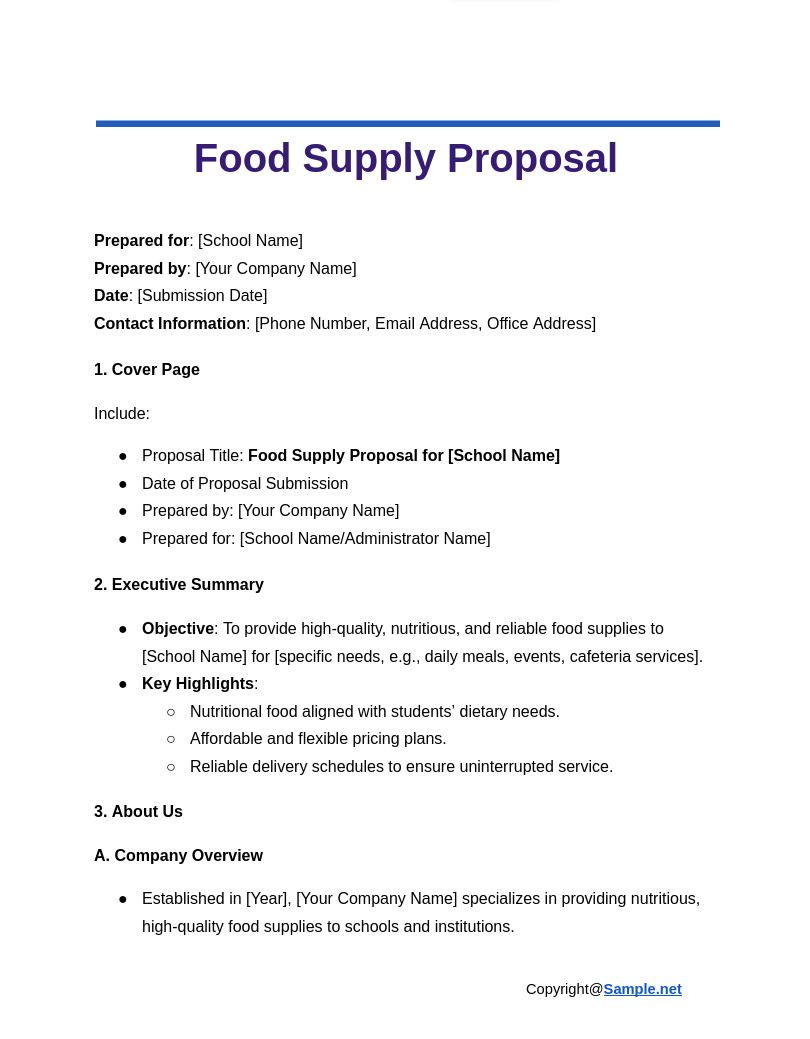
Food Supply Proposal to a School
download now -
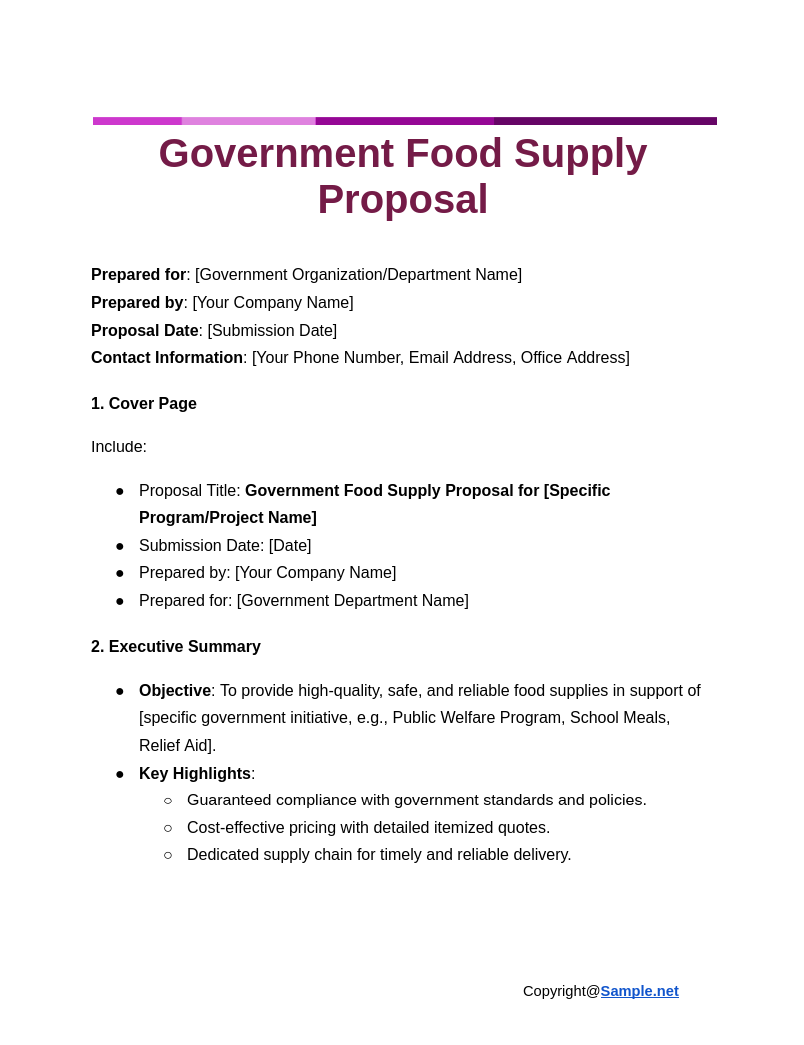
Government Food Supply Proposal
download now -
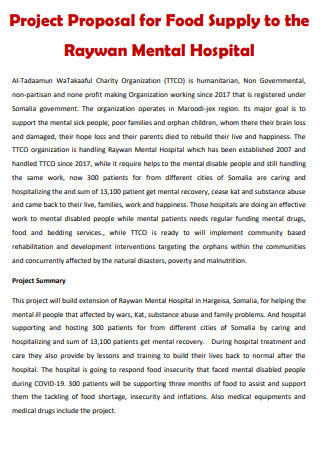
Food Supply Project Proposal
download now -
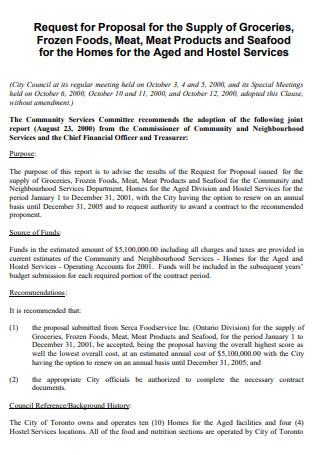
Frozen Food Supply Proposal
download now -
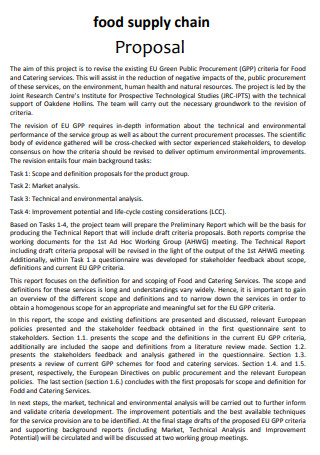
Food Supply Chain Proposal
download now -
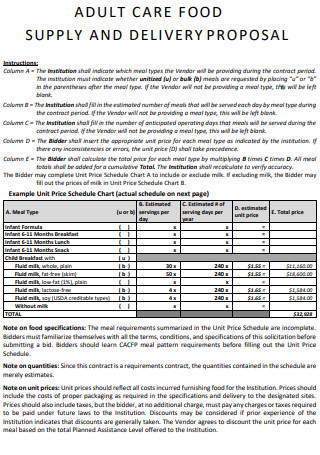
Adult Care Food Supply Proposal
download now -
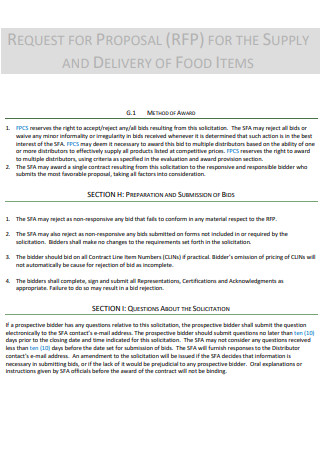
Delivery of Food Supply Proposal
download now -
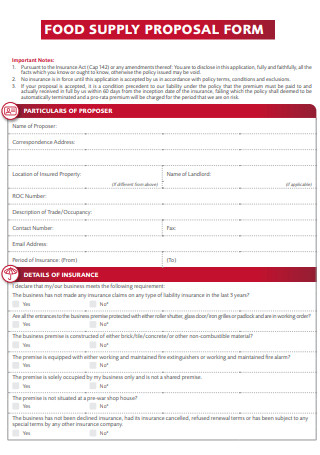
Food Supply Proposal Form
download now -
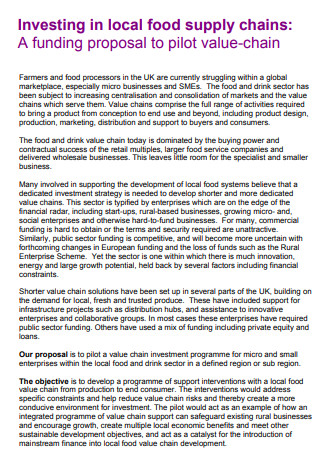
Local Food Supply Proposal
download now -
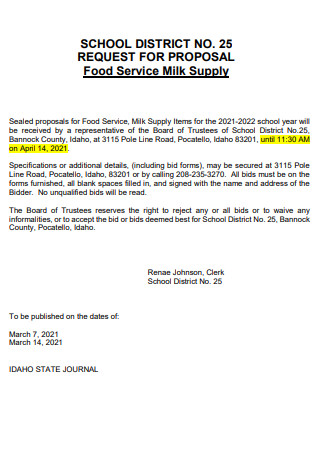
Food Service Milk Supply Proposal
download now
FREE Food Supply Proposal s to Download
Food Supply Proposal Format
Food Supply Proposal Samples
What is a Food Supply Proposal?
Purposes of a Food Supply Proposal
Steps On How to Write a Food Supply Proposal
FAQs
What Are the Consequences of Unpredictable Food Supply?
What Are the Examples of Food Suppliers?
How To Create an Emergency Food Supply?
What makes a food supply proposal successful?
How do I present a food supply proposal?
What challenges can arise in food supply logistics?
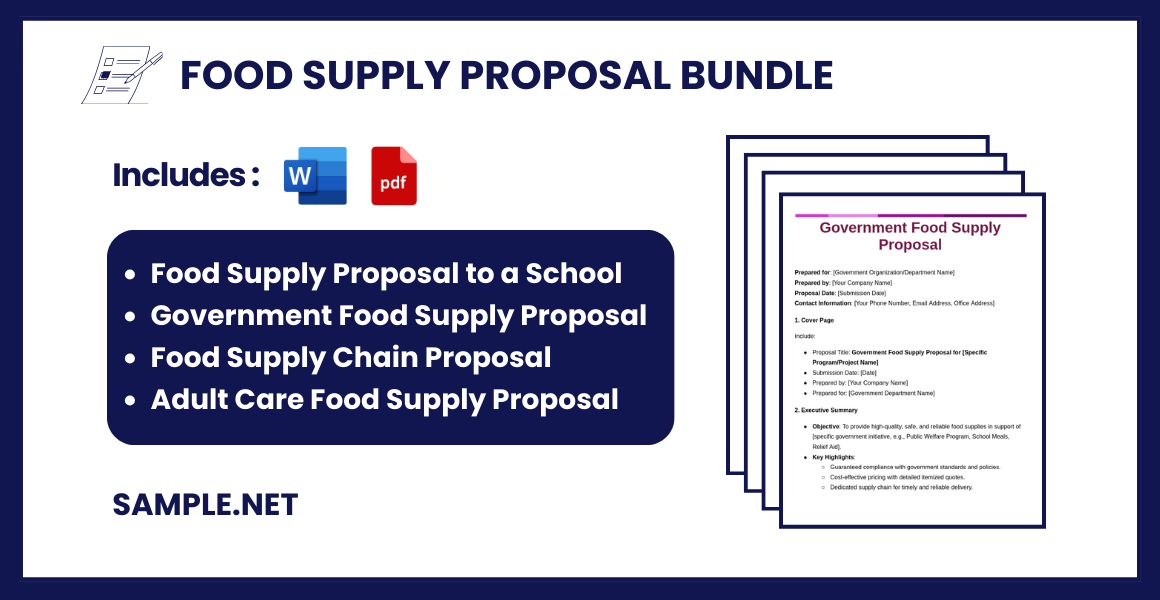
Download Food Supply Proposal Bundle
Food Supply Proposal Format
1. Cover Page
- Title: Food Supply Proposal
- Prepared by: [Your Company Name]
- Prepared for: [Client/Organization Name]
- Date: [Proposal Date]
- Contact Information: [Your Phone Number, Email Address, and Office Address]
2. Executive Summary
- Objective: Briefly state the purpose of the proposal, e.g., providing high-quality, cost-effective, and timely food supply services.
- Highlights: Summarize key points like services offered, quality assurance, and delivery timelines.
3. Company Overview
- About Us: A brief introduction to your company, mission, vision, and years of experience in food supply.
- Core Values: Highlight values such as quality, reliability, and sustainability.
- Certifications: Include relevant certifications (e.g., ISO standards, health and safety compliance).
4. Proposal Details
A. Scope of Services
- Types of food supplies offered (e.g., fresh produce, packaged goods, catering supplies).
- Service area coverage and delivery frequency.
- Storage and transportation methods (e.g., refrigerated vehicles).
B. Product List
- Category 1: [e.g., Fresh Vegetables]
- Item 1: [Name and description]
- Item 2: [Name and description]
- Category 2: [e.g., Packaged Goods]
- Item 1: [Name and description]
C. Delivery Schedule
- Specify delivery frequency (e.g., daily, weekly).
- Timelines for each service area.
5. Quality Assurance
- Standards and Procedures: Detail the quality control measures in place.
- Food Safety Compliance: Mention adherence to health and safety regulations.
- Sustainability Practices: Highlight eco-friendly or ethical sourcing methods.
6. Pricing and Payment Terms
A. Pricing Breakdown
- Include unit prices, bulk discounts, and package rates.
- Delivery charges, if applicable.
B. Payment Terms
- Payment methods (e.g., bank transfer, credit terms).
- Payment schedule (e.g., upon delivery, monthly billing).
7. Benefits of Working with Us
- Highlight the unique value your company provides, such as:
- Competitive pricing.
- Reliable delivery schedules.
- Exceptional customer support.
8. Terms and Conditions
- Contract duration.
- Cancellation and refund policies.
- Liability and warranty disclaimers.
9. Appendices
- Product catalogs or menus.
- Certifications and licenses.
- Testimonials or references from past clients.
10. Acceptance of Proposal
Include a section for the client to sign and date, indicating acceptance of the proposal:
Client Name: _____________________
Signature: _____________________
Date: _____________________
What is a Food Supply Proposal?
A food supply proposal is a formal document that details the plan for delivering food supplies to a designated recipient or organization. It includes the estimated costs, delivery schedules, quality standards, and sourcing methods. These proposals are crucial for event planning, corporate catering, disaster relief programs, or school nutrition initiatives. By outlining the responsibilities and timelines, it creates a clear roadmap for effective food distribution while ensuring compliance with food safety standards. You can also see more on Product Supply Proposal.
Purposes of a Food Supply Proposal
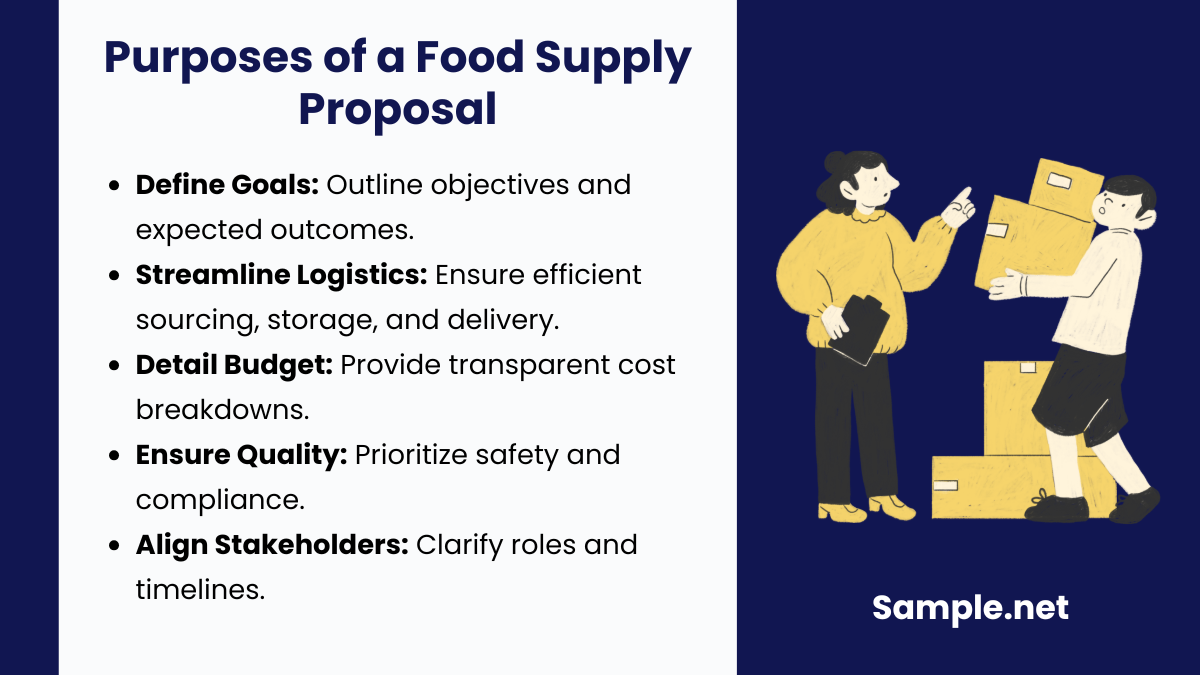
1. Define Objectives and Scope:
A food supply proposal clearly outlines the goals and scope of the supply plan. Whether it’s providing meals for an event or ensuring long-term food distribution for a school, it specifies the purpose, requirements, and expected outcomes.
2. Streamline Food Logistics:
The proposal ensures a well-organized approach to food sourcing, storage, and delivery. It lays out logistics in a systematic manner, minimizing delays and inefficiencies. You can also see more on Catering Service Proposal.
3. Budget Planning and Transparency:
By detailing costs, such as procurement, transportation, and labor, the proposal enables stakeholders to understand financial requirements, ensuring transparency and efficient allocation of funds.
4. Ensure Quality and Compliance:
The proposal emphasizes food safety, quality standards, and compliance with regulations. This builds trust and guarantees adherence to health and safety norms.
5. Facilitate Stakeholder Alignment:
A food supply proposal acts as a communication tool, aligning all stakeholders—suppliers, transporters, and recipients—toward a common goal with clear responsibilities and timelines. You can also see more on Food Security Proposal.
Steps On How to Write a Food Supply Proposal
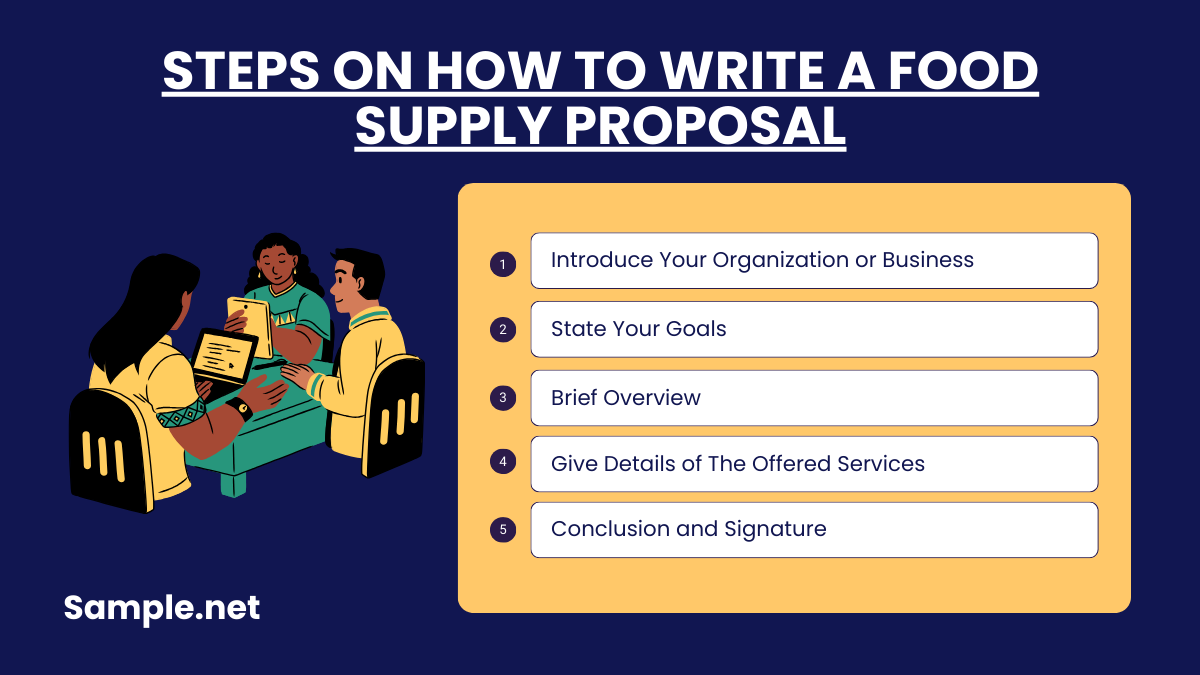
So, have I persuaded you to download and print that proposal for food supply pdf? Not yet, is it? So, let’s get down to business and talk about how you could write one instead. Here are the steps you can take:
Step 1: Introduce Your Organization or Business
It’s great if you give them a sense of who you are before introducing your services. Your missions and goals, as well as how they relate to your food supply agenda. You can go into detail about how you run your business, where you’ve done most of your business, and why you’re presenting your services. It’s a way for investors or prospective clients to get a sense of what your company is about and why they should do business with you. You can also see more on Catering Bid Proposal.
Step 2: State Your Goals
Giving them an idea of your future goals and how you think it will progress further is a wonderful method to earn their attention and help them understand who you are and what sort of services you offer. Stating your objectives offers a solid foundation for the type of transactions you desire to provide and how you expect it to benefit them.
Step 3: Brief Overview
You can give your clients a high-level summary of how you want to run or build the business. For example, your initial step could be to perform market research report in order to reach out to potential clients. Or how you will benefit financially if they invest and where and how their investment is going to be used and spent. The overview is a synopsis of what is to come in the document. It will determine why your target market is the goal and how you want to handle the business in the future.
Step 4: Give Details of The Offered Services
One strategy to persuade investors is to show them the services you can provide. It’s a big impact in whether or not your proposal is approved. You can, for example, specify the frequency with which you deliver to businesses and institutions. Your product’s quantity and quality. Most importantly, whether this includes delivery services and other extra features you may provide to make it more enticing. For example, an added service in long-term contracts.
Step 5: Conclusion and Signature
Last but not least, your proposal’s conclusion. You can list the measures they can take if they approve like how to contact and reach out to you, as well as the steps you will take if they do. Concluding how much you need their support and how much it would mean if the proposal were approved. Below the conclusion is the part where you can state your name and signature to validate the proposal. You can also see more on Restaurant Service Proposal.
FAQs
What Are the Consequences of Unpredictable Food Supply?
An unpredictable food supply would lead to food insecurity and frequent fluctuations of prices in the market resulting to a higher price conclusion. It will also lead to the problem of availability and at worst, stop a business from functioning to the damage it did financially. One of the most obvious effect of an unpredictable food supply is also the scarcity it will provide, and the problems that could arise such as increased hunger and sickness within a community.
What Are the Examples of Food Suppliers?
Local farmers and producers that use their own farm and land on which to develop their produce are the best examples of food suppliers. They are at the pinnacle of the food supply chain. As well as food processing and manufacturing companies that specialize in ready-to-eat foods that they subsequently distribute to the market and shops. You can also see more on Catering Contract Proposal.
How To Create an Emergency Food Supply?
When calamities and emergencies strike unexpectedly, it is always wise to be prepared. To survive, you may need to consume stored food. One thing to keep in mind while preparing your own emergency food supply is whether any family members in the household are allergic to it and whether it can be eaten. Most crucial, if it can be safely stored in the first place. It’s a good idea to double-check the expiration dates on canned and pre-made foods. Emergency foods are preferable when they don’t need to be cooked or can be consumed without any additional preparation. Building a good storage will help assure the safety of the food before consumption.
What makes a food supply proposal successful?
Clarity, thoroughness, and alignment with client needs are key. A detailed needs assessment, transparent budgeting, and a focus on quality ensure its effectiveness. You can also see more on Vendor Partnership Proposal.
How do I present a food supply proposal?
Use a professional and visually appealing format. Include an executive summary, charts, and clear headings to make it engaging and easy to follow.
What challenges can arise in food supply logistics?
Common issues include delays in delivery, storage limitations, and maintaining freshness during transportation. Highlight contingency plans in your proposal to address these. You can also see more on Agricultural Project Proposal.
